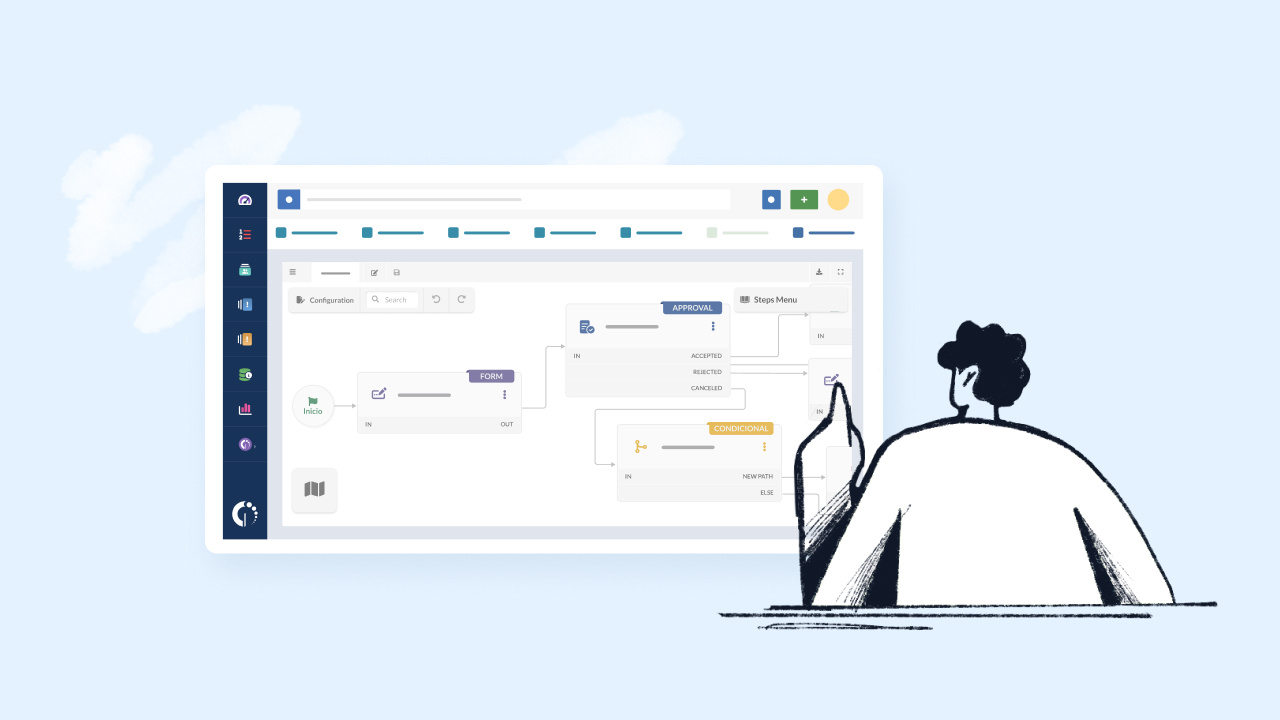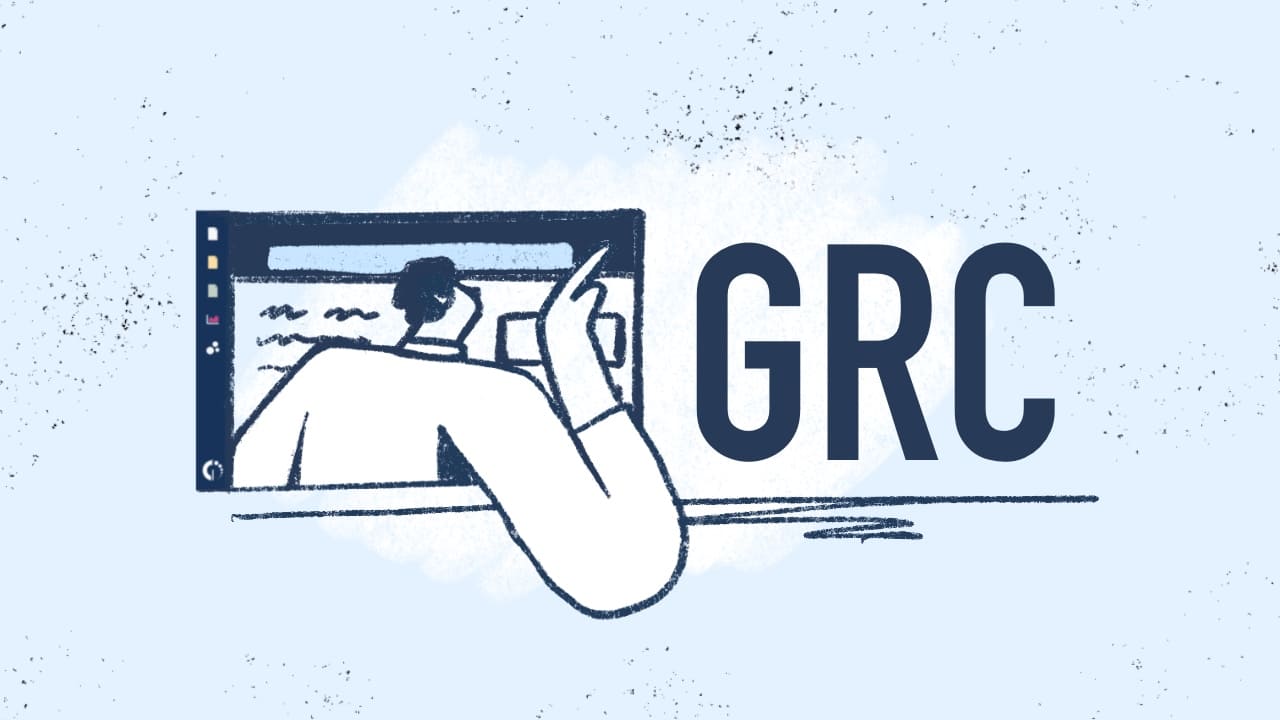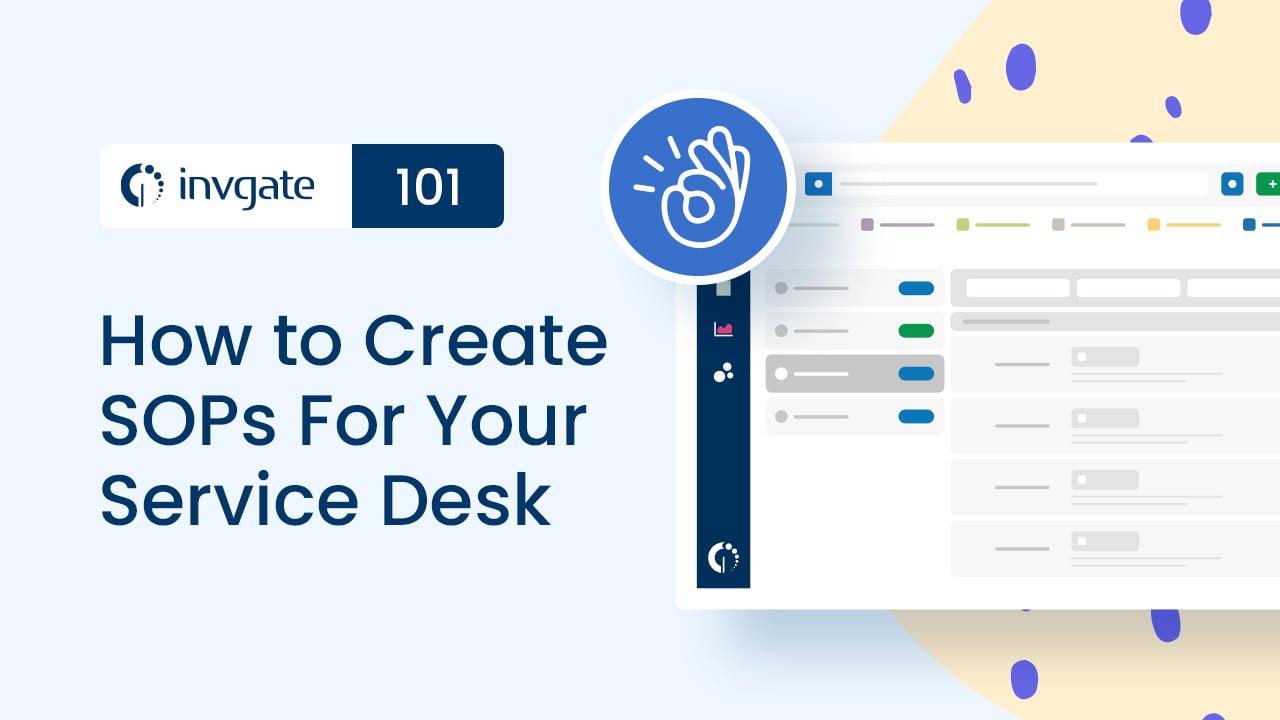Standard Operating Procedures (SOPs) are the backbone of any well-run organization, providing a clear roadmap for employees to follow and ensuring consistency across all aspects of the business. By implementing effective SOPs, companies can unlock a world of benefits, from improved productivity and reduced costs to enhanced customer satisfaction and better risk management.
SOPs provide detailed guidance for critical business processes such as marketing, sales, customer support, and HR, ensuring efficiency and maintaining quality.
In this article, we’ll explore the transformative power of Standard Operating Procedures and dive into a range of practical SOP examples that can help streamline your business operations. Whether you’re looking to optimize your IT Asset Management, enhance your customer service protocols, or strengthen your financial management processes, we’ve got you covered.
Spoiler alert: We included not one, but two downloadable SOP templates.

What are Standard Operating Procedures (SOPs)?
A Standard Operating Procedure is a detailed, written instruction that describes how to perform a specific task or process. SOPs are crucial for maintaining quality control and ensuring that employees follow consistent methods when carrying out their duties.
They can be used in various industries, including healthcare, manufacturing, and IT.
SOPs typically include the following elements:
-
Purpose: The reason for the SOP and its intended outcome.
-
Scope: The areas or departments the SOP applies to.
-
Responsibilities: Who is responsible for executing the Standard Operating Procedure.
-
Procedure: Step-by-step instructions on how to complete the task.
-
References: Any related documents or resources.
By providing clear guidelines, Standard Operating Procedures help organizations minimize errors, enhance training, and improve overall efficiency.

Why are Standard Operating Procedures so important?
SOPs play a vital role in any organization, and their importance cannot be overstated. Here are several reasons why SOPs are crucial:
-
Consistency: SOPs ensure that tasks are performed consistently, regardless of who is executing them. This consistency helps maintain quality and reliability in products and services.
-
Training: New employees can use SOPs as training tools to understand their roles and responsibilities. Having clear guidelines makes onboarding smoother and more efficient.
-
Compliance: Many industries are subject to regulations that require specific procedures to be documented. SOPs help organizations comply with these regulations and avoid potential legal issues.
-
Efficiency: By outlining best practices, SOPs can streamline processes and reduce the time spent on tasks. Employees can quickly reference the SOP to find the information they need.
-
Risk Management: SOPs help identify potential risks and outline steps to mitigate them. This proactive approach can prevent accidents and enhance workplace safety.
How to create Standard Operating Procedures?
Creating an effective Standard Operating Procedure involves a systematic approach to ensure clarity and usability.
Remember that you can utilize AI-powered tools in the SOP creation process to streamline drafting and enhance collaboration. These tools can generate structured outlines, content for each section, and incorporate insights from existing process documentation.
Also, do not underestimate SOP documentation. Creating, managing, updating, and promoting SOP documents is crucial for achieving workflow consistency.
Here’s a step-by-step guide to help you craft SOPs that meet your organization’s needs:
-
Identify the purpose: Start by determining the specific task or process that the SOP will address. Clearly define the purpose and the desired outcome of the procedure.
-
Gather input: Involve relevant stakeholders, including employees who perform the task, managers, and subject matter experts. Their insights will help ensure the SOP is comprehensive and practical.
-
Outline the scope: Define the scope of the SOP, including which departments or roles it applies to and any limitations or exclusions.
-
Draft the procedure: Create a step-by-step outline of the procedure. Use clear, concise language and consider breaking down complex tasks into manageable steps. Include any necessary tools, resources, or references.
-
Assign responsibilities: Clearly outline who is responsible for each step of the procedure. This ensures accountability and helps employees understand their roles.
-
Review and revise: Share the draft SOP with stakeholders for feedback. Revise the document based on their input to ensure clarity and effectiveness.
-
Test the SOP: Before finalizing, conduct a trial run of the SOP to identify any potential issues or areas for improvement. Make adjustments as needed.
-
Implement and train: Once finalized, distribute the SOP to all relevant employees and provide training to ensure everyone understands the procedure.
-
Monitor and update: Regularly review the SOP to ensure it remains relevant and effective. Update it as necessary to reflect changes in processes, technology, or regulations.
SOP best practices
To create effective and user-friendly Standard Operating Procedures, consider the following best practices:
-
Use a clear SOP format: A standardized format for your SOPs makes them easier to read and follow. Include sections like Purpose, Scope, Responsibilities, Procedures, and References. Consistency in format helps employees quickly locate the information they need.
-
Be concise: Use simple, straightforward language to explain procedures. Avoid jargon or overly technical terms unless necessary, and define any terms that may be unfamiliar to the reader.
-
Incorporate visual aids: Where applicable, include diagrams, flowcharts, or images to illustrate complex processes. Visual aids can enhance understanding and retention of information.
-
Engage stakeholders in development: Involve employees who will use the Standard Operating in the development process. Their input can provide valuable insights and help ensure the SOP is practical and relevant.
-
Regularly review and update: Set a schedule for reviewing Standard Operating Procedures to ensure they remain current and effective. Update them as needed to reflect changes in processes, technology, or regulations.
-
Provide training and support: Ensure that employees receive training on new or updated SOPs. This support can help them understand the procedures and their importance, leading to better compliance.
-
Encourage feedback: Create a mechanism for employees to provide feedback on SOPs. This input can help identify areas for improvement and ensure that the SOPs are meeting their intended goals.
10 SOP examples
There are many SOP examples to learn from. And, now that we understand what SOPs are and why they’re important, we can finally explore ten practical SOP examples that can be applied across various departments.
Each example will provide a framework that you can adapt to your organization’s specific needs.
1. Customer Service SOP
A Customer Service SOP provides guidelines for handling customer inquiries and complaints. This SOP ensures that customer service representatives deliver consistent and high-quality support. It can also help in resolving customer issues.
It is a good idea to involve the marketing department in planning and executing customer service strategies to ensure alignment with the brand's messaging.
Key components of a Customer Service SOP:
-
Purpose: To enhance customer satisfaction through effective communication and problem-solving.
-
Scope: Applies to all customer service interactions.
-
Responsibilities: Customer service representatives are responsible for addressing inquiries and complaints.
Procedure:
-
Greeting customers: Use a friendly and professional greeting when interacting with customers.
-
Identifying issues: Ask open-ended questions to understand the customer’s issue fully.
-
Providing solutions: Offer solutions based on company policies and procedures, ensuring clarity and transparency.
-
Follow-up: After resolving the issue, follow up with the customer to ensure satisfaction.
2. Quality Control SOP
A Quality Control SOP outlines the procedures for ensuring that products meet established quality standards. This SOP is essential for maintaining product integrity and customer trust.
Key components of a Quality Control SOP:
-
Purpose: To ensure products meet quality specifications before reaching customers.
-
Scope: Applies to all products manufactured or sold by the organization.
-
Responsibilities: Quality control personnel are responsible for conducting inspections and tests.
Procedure:
-
Inspection criteria: Define the criteria for inspecting products, including appearance, functionality, and safety.
-
Testing procedures: Outline the testing methods used to evaluate product quality.
-
Documentation: Maintain records of inspections and test results for accountability.
-
Corrective actions: Establish a process for addressing quality issues, including rework or product recalls.
3. Human Resources SOP
A Human Resources SOP provides guidelines for managing employee-related processes, such as recruitment, onboarding, and performance evaluations. This SOP helps ensure compliance with labor laws and company policies.
Key components of a Human Resources SOP:
-
Purpose: To standardize HR processes and ensure fair treatment of employees.
-
Scope: Applies to all HR activities within the organization.
-
Responsibilities: HR personnel are responsible for implementing and overseeing HR processes.
Procedure:
-
Recruitment process: Outline steps for posting job openings, reviewing applications, and conducting interviews.
-
Employee onboarding process: Define the onboarding process for new hires, including orientation and training.
-
Performance evaluations: Establish a timeline and criteria for conducting employee performance reviews.
-
Employee relations: Provide guidelines for addressing employee concerns and grievances.

4. Financial Management SOP
A Financial Management SOP outlines the procedures for managing an organization’s finances, including budgeting, expense tracking, and financial reporting. This SOP is crucial for maintaining financial health and accountability.
Key components of a Financial Management SOP:
-
Purpose: To ensure accurate financial management and reporting.
-
Scope: Applies to all financial transactions and reporting activities.
-
Responsibilities: Finance personnel are responsible for managing financial processes.
Procedure:
-
Budgeting process: Define the steps for creating and approving budgets.
-
Expense tracking: Outline procedures for tracking and approving expenses.
-
Financial reporting: Establish a timeline for generating financial reports and distributing them to stakeholders.
-
Audit procedures: Define the process for conducting internal audits and addressing discrepancies.
5. Marketing SOP
A Marketing SOP provides guidelines for executing marketing campaigns and activities. This SOP ensures that marketing efforts are aligned with company goals and brand messaging.
It is crucial to align all marketing efforts with the overall marketing strategy to maintain relevance, accuracy, and engagement.
Key components of a Marketing SOP:
-
Purpose: To standardize marketing processes and enhance campaign effectiveness.
-
Scope: Applies to all marketing activities and campaigns.
-
Responsibilities: Marketing personnel are responsible for planning and executing marketing initiatives.
Procedure:
-
Campaign planning: Outline steps for developing marketing campaign strategies, including target audience and messaging.
-
Content creation: Define processes for creating and approving marketing content.
-
Performance measurement: Establish metrics for evaluating campaign success and reporting results.
-
Brand guidelines: Provide guidelines for maintaining brand consistency across all marketing materials.
6. Safety and Compliance SOP
A Safety and Compliance SOP outlines the procedures for ensuring workplace safety and compliance with regulations. This SOP is essential for protecting employees and minimizing legal risks.
Key components of a Safety and Compliance SOP:
-
Purpose: To promote a safe working environment and ensure compliance with regulations.
-
Scope: Applies to all employees and workplace activities.
-
Responsibilities: Safety officers are responsible for implementing safety protocols.
Procedure:
-
Safety training: Define the training requirements for employees regarding safety procedures.
-
Incident reporting: Outline steps for reporting workplace incidents and near misses.
-
Compliance audits: Establish a schedule for conducting safety audits and inspections.
-
Emergency procedures: Provide guidelines for responding to emergencies, including evacuation plans.

7. IT Security SOP
An IT Security SOP outlines the procedures for protecting an organization’s information and technology assets. This SOP is crucial for safeguarding sensitive data and preventing cyber threats.
Key components of an IT Security SOP:
-
Purpose: To ensure the security of IT systems and data.
-
Scope: Applies to all IT assets and personnel.
-
Responsibilities: IT security personnel are responsible for implementing security measures.
Procedure:
-
Access control: Define procedures for granting and revoking access to IT systems.
-
Data protection: Outline steps for protecting sensitive data, including encryption and backup procedures.
-
Incident response: Establish a process for responding to security incidents and breaches.
-
Security training: Provide guidelines for training employees on security best practices.
8. Procurement SOP
A Procurement SOP outlines the procedures for acquiring goods and services for the organization. This SOP ensures that procurement processes are efficient, transparent, and compliant with policies.
Key Components of a Procurement SOP:
-
Purpose: To standardize procurement processes and ensure cost-effectiveness.
-
Scope: Applies to all procurement activities within the organization.
-
Responsibilities: Procurement personnel are responsible for managing purchasing processes.
Procedure:
-
Vendor selection: Define criteria for selecting vendors and conducting evaluations.
-
Purchase orders: Outline the process for creating and approving purchase orders.
-
Receiving goods: Establish procedures for receiving and inspecting goods upon delivery.
-
Payment processing: Provide guidelines for processing payments to vendors.
9. IT Asset Management SOP
An IT Asset Management SOP outlines the processes for tracking and managing an organization’s IT assets, including hardware and software. This SOP helps ensure that assets are accounted for, maintained, and disposed of properly.
Key components of an IT Asset Management SOP:
-
Purpose: To maintain an accurate inventory of IT assets and ensure efficient utilization.
-
Scope: Applies to all IT assets owned by the organization.
-
Responsibilities: IT staff are responsible for tracking assets, while department heads must report any changes.
Procedure:
-
Asset inventory: Maintain a centralized database of all IT assets, including purchase date, location, and assigned user.
-
Asset tracking: Implement a system for tracking asset movement, including check-in/check-out procedures.
-
Maintenance schedule: Establish a routine maintenance schedule for hardware and software updates.
-
Disposal procedures: Outline steps for the secure disposal of outdated or non-functional assets, including data wiping protocols.
ITAM free SOP template
There are a lot of SOP templates to download and use and we bring you a specific one: a IT Asset Management SOP template.
Along with this SOP document, you’ll receive an example of a SOP for capturing asset information. It contains the following aspects of the asset capture process:
-
Receiving the asset.
-
Labeling the asset with an asset tag.
-
Entering the asset into the ITAM database.
-
Deploying the asset.
-
Updating the asset.
-
Retiring the asset.
-
Disposing of the asset.
![The Asset Management SOP Playbook [+Free Template]](https://blog.invgate.com/hubfs/how-to-build-an-asset-management-sop-1.jpg)
10. IT Service Management SOP
A Service Desk SOP defines the processes for delivering IT services to users, ensuring that support requests are handled efficiently and effectively. This SOP is crucial for maintaining high levels of user satisfaction.
Using a SOP document can streamline IT service management processes and ensure a clear flow of information.
Key components of an IT Service Management SOP:
-
Purpose: To provide a structured approach to managing IT services and support.
-
Scope: Applies to all IT service requests and incidents.
-
Responsibilities: IT support staff are responsible for resolving issues, while users must report problems promptly.
Procedure:
-
Incident reporting: Users report incidents through a designated ticketing system.
-
Ticket assignment: Support staff assess and assign tickets based on priority and expertise.
-
Resolution process: Follow a standardized process for troubleshooting and resolving incidents, including escalation procedures for complex issues.
-
Closure and feedback: Once resolved, close the ticket and request user feedback to improve service quality.
ITSM free SOP template
Once again, there are many ITSM SOP examples of Service Desk processes. It’s always important that you cover each stage of the workflow, and that your company’s specific requirements are considered in the design.
Here we have put together an example of an ITSM SOP for logging incidents that you can download below and adapt to your own work scenario. It contains the following aspects of the process:
-
Logging the incident.
-
Categorization.
-
Prioritization.
-
Initial support.
-
Investigation and diagnosis.
-
Escalation.
-
Resolution.
-
Closure.

Conclusion
In conclusion, Standard Operating Procedures are essential tools for ensuring consistency, quality, and efficiency across various organizational processes. By implementing the SOP examples discussed in this article, you can create a solid foundation for your organization’s operations.
Whether it’s ITAM, customer service, or Financial Management, having clear SOPs in place can significantly enhance your team’s performance and overall success. Ready to create your own SOPs? Start today and watch your organization thrive!
Frequently Asked Questions (FAQs)
1. What is the purpose of a Standard Operating Procedure (SOP)?
The purpose of an SOP is to provide clear, detailed instructions for performing specific tasks or processes, ensuring consistency and quality across an organization.
2. Why are SOPs important for organizations?
SOPs are important because they promote consistency, enhance training, ensure compliance with regulations, improve efficiency, and help manage risks.
3. Can you provide SOP examples?
Yes! Examples of SOPs include IT Asset Management SOP, IT Service Management SOP, Customer Service SOP, Quality Control SOP, and many others tailored to specific organizational needs.
4. How can I create effective SOPs for my organization?
To create effective SOPs, define the purpose and scope, outline clear procedures, assign responsibilities, and regularly review and update the documents as needed.















